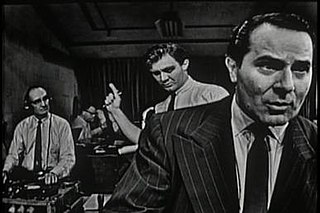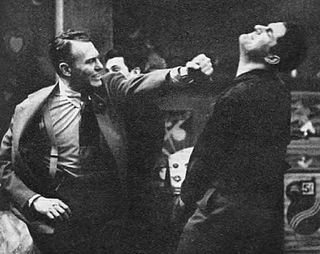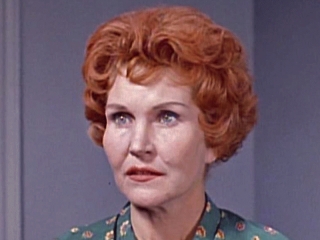Related Research Articles
The year 1958 in television involved some significant events. Below is a list of television-related events during 1958.
The year 1956 in television involved some significant events. Below is a list of television-related events during 1956.
The year 1950 in television involved some significant events. Below is a list of television-related events during 1950.

Armstrong Circle Theatre is an American anthology drama television series which ran from June 6, 1950, to June 25, 1957, on NBC, and from October 2, 1957, to August 28, 1963, on CBS. It alternated weekly with The U.S. Steel Hour. It finished in the Nielsen ratings at number 19 for the 1950–51 season and number 24 for 1951–52. The principal sponsor was Armstrong World Industries.

The first Golden Age of Television is an era of television in the United States marked by its large number of live productions. The period is generally recognized as beginning in 1947 with the first episode of the drama anthology Kraft Television Theater and ending in 1960 with the final episode of Playhouse 90. The Golden Age was followed by the network era, wherein television audiences and programming had shifted to less critically acclaimed fare, almost all of it taped or filmed.
The following is the 1958–59 network television schedule for the four major English language commercial broadcast networks in the United States. The schedule covers primetime hours from September 1958 through March 1959. The schedule is followed by a list per network of returning series, new series, and series cancelled after the 1957–58 season.
The Philco Television Playhouse is an American television anthology series that was broadcast live on NBC from 1948 to 1955. Produced by Fred Coe, the series was sponsored by Philco. It was one of the most respected dramatic shows of the Golden Age of Television, winning a 1954 Peabody Award and receiving eight Emmy nominations between 1951 and 1956.
The following is the 1957–58 network television schedule for the four major English language commercial broadcast networks in the United States. The schedule covers primetime hours from September 1957 through March 1958. The schedule is followed by a list per network of returning series, new series, and series cancelled after the 1956–57 season.
The 1955–56 network television schedule for the four major English language commercial broadcast networks in the United States. The schedule covers primetime hours from September 1955 through March 1956. The schedule is followed by a list per network of returning series, new series, and series cancelled after the 1954–55 season.

The Colgate Comedy Hour is an American comedy-musical variety series that aired live on the NBC network from 1950 to 1955. The show featured many notable comedians and entertainers of the era as guest stars. Many of the scripts of the series are archived at the UCLA Library in their Special Collections.
The following is the 1956–57 network television schedule for the three major English language commercial broadcast networks in the United States. The schedule covers primetime hours from September 1956 through March 1957. The schedule is followed by a list per network of returning series, new series, and series cancelled after the 1955–56 season.
The following is the 1950–51 network television schedule for the four major English language commercial broadcast networks in the United States. The schedule covers primetime hours from September 1950 through March 1951. The schedule is followed by a list per network of returning series, new series, and series cancelled after the 1949–50 season. This season became the first in which primetime was entirely covered by the networks. It was also the inaugural season of the Nielsen rating system. Late in the season, the coast-to-coast link was in service.

Ford Theatre, spelled Ford Theater for the original radio version and known, in full, as The Ford Television Theatre for the TV version, is a radio and television anthology series broadcast in the United States in the 1940s and 1950s. At various times the television series appeared on all three major television networks, while the radio version was broadcast on two separate networks and on two separate coasts. Ford Theatre was named for its sponsor, the Ford Motor Company, which had an earlier success with its concert music series, The Ford Sunday Evening Hour (1934–42).

The Paramount Television Network, Inc. was a venture by American film corporation Paramount Pictures to organize a television network in the late 1940s. The company-built television stations KTLA in Los Angeles and WBKB in Chicago; it also invested $400,000 in the DuMont Television Network, which operated stations WABD in New York City, WTTG in Washington, D.C., and WDTV in Pittsburgh. Escalating disputes between Paramount and DuMont concerning breaches of contract, company control, and network competition erupted regularly between 1940 and 1956, culminating in the DuMont Network's dismantling. Television historian Timothy White called the clash between the two companies "one of the most unfortunate and dramatic episodes in the early history of the television industry."
Actors Studio is an American television series that was hosted by Marc Connelly. It originally aired on ABC from September 26, 1948 to October 26, 1949 and then on CBS from November 1, 1949, to June 23, 1950. It was one of the first series to be picked up by a network after being cancelled by another network. CBS departed from its own precedent when it took the World Video-owned series. Until then it had not shown any sustaining programs that were not owned by CBS.
The Best of Broadway is a 60-minute live television anthology series that aired on CBS Television on Wednesdays at 10 p.m. Eastern Standard Time from September 15, 1954, to May 4, 1955, for a total of nine episodes. Each show was broadcast live in color from New York City, was an adaptation of a famous Broadway play, and included commercials for Westinghouse featuring Betty Furness. Using a "giant new studio," plays were presented in front of a studio audience, which contributed a Broadway-like element.

Man Against Crime starring Ralph Bellamy, one of the first television programs about private eyes, ran on CBS, the DuMont Television Network and NBC from October 7, 1949, to June 27, 1954, and was briefly revived, starring Frank Lovejoy, during 1956. The show was created by Lawrence Klee and was broadcast live until 1952. The series was one of the few television programs ever to have been simulcast on more than one network: the program aired on both NBC and DuMont during the 1953–54 television season.

The Bigelow Theatre is an American anthology series originally broadcast on CBS Television and on the DuMont Television Network.

Startime is an anthology show of drama, comedy, and variety, and was one of the first American television shows broadcast in color. The program was aired Tuesday nights in the United States on the NBC network in the 1959–60 season.

The Elgin Hour is a 60-minute live American anthology drama that aired from October 5, 1954 to June 14, 1955, on ABC, alternating with The United States Steel Hour.
References
- ↑ "Cheer Television Theatre". www.tvtango.com. Retrieved October 26, 2014.
- 1 2 Brooks, Tim; Marsh, Earle F. (24 June 2009). The Complete Directory to Prime Time Network and Cable TV Shows, 1946-Present. Random House Publishing Group. p. 242. ISBN 978-0-307-48320-1 . Retrieved March 14, 2021.
- ↑ McNeil, Alex (1996). Total Television (4th ed.). New York, New York: Penguin Books USA, Inc. p. 158. ISBN 0-14-02-4916-8.